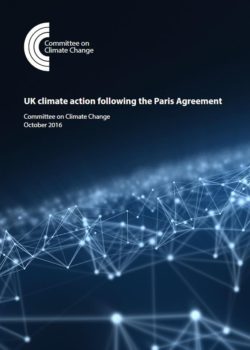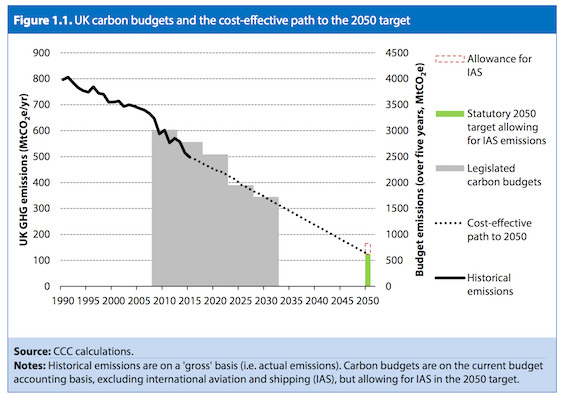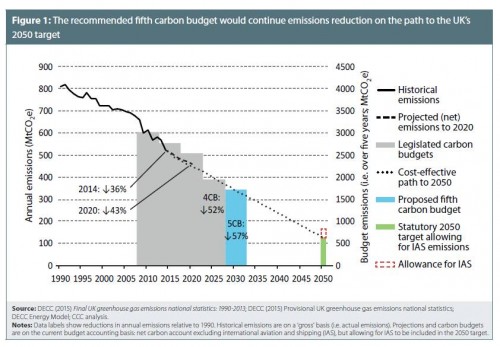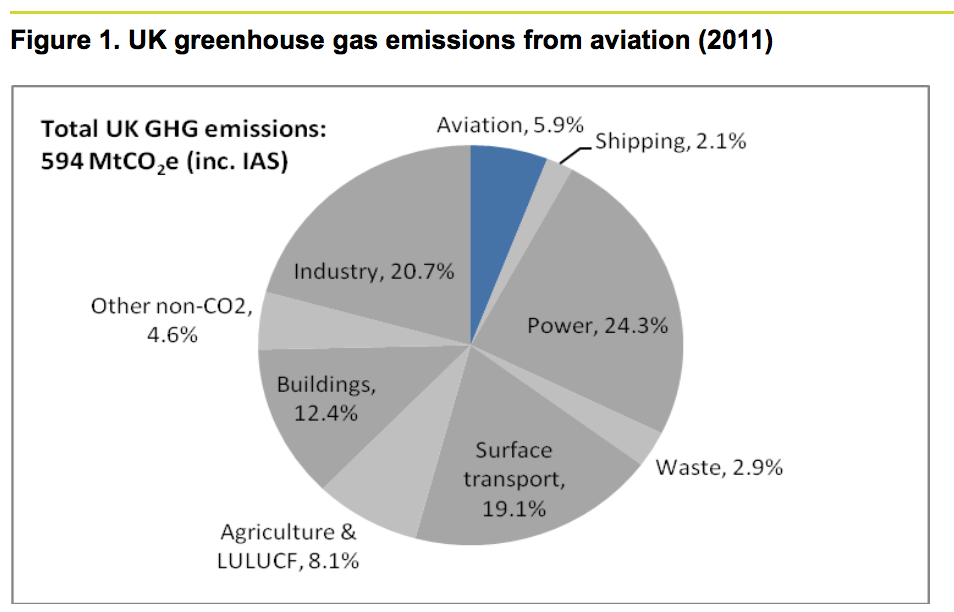Little new on aviation in CCC advice after Paris Agreement – STILL waiting for Government policy on aviation CO2
The Committee on Climate Change has produced its advice to government on UK climate action following the Paris Agreement last December. It sees aviation as a “challenging” or “hard to treat” sector from which to cut emissions. The CCC advocates greenhouse gas removal options (e.g. afforestation, carbon-storing materials, bioenergy with carbon capture and storage) to help deal with these CO2 emissions. It is aware that the option for these measures is limited, though it suggests 10% use of biofuel in aircraft eventually (and reduced red meat consumption in diets as a solution …) The CCC suggests shifting demand to lower emissions alternatives (e.g. virtual conferencing in place of international air travel). The CCC say government should develop strategies for greenhouse gas removal technologies and reducing emissions from the hardest-to-treat sectors eg. aviation. The CCC continues to say UK aviation CO2 emissions should not be above 37.5MtCO2 by 2050. They have said (Nov 2015) that government should publish an effective policy framework for aviation emissions by autumn 2016. This has NOT happened. While international aviation is not yet included in UK carbon budgets, the CCC said in Nov 2015 that it would “provide further advice following the ICAO negotiations in 2016, and recommend that Government revisit inclusion at that point.” No mention of that yet.
.
Tweet
New CCC advice offers no wriggle-room on aviation emissions

A new report from the Committee on Climate Change, published today, on how to deliver the ambitious climate targets agreed in Paris in 2015 identifies aviation as a ‘hard to treat’ sector and continues to caution against unlimited passenger growth.
The Government’s priority, CCC advises, should be to act ‘with urgency’ to close the policy gap for achieving existing climate commitment. The Climate Change Act requires the UK to cut total emissions by 80% of their 1990 levels by 2050 in order to limit the risk of exceeding 2 degrees of warming. [ie. to about 160 Mt CO2 per year]
Today’s report reiterates the CCC’s advice that new policy is required to ensure that UK aviation emissions are limited to around 2005 levels by 2050 (37.5Mt), implying no more than a 60% increase in passenger demand. [The CCC has been asking government for this since June 2015 – nothing has been produced. See link AW note]
The most recent Government forecasts predicted demand growth of 93% even on the assumption that aviation was exposed to carbon pricing and that no new runways were approved. The Airports Commission, in its analysis of possible airport expansion in the South East, predicted that emissions would increase further if a new runway was built, but offered no recommendations for how emissions and passenger growth could be limited to a sustainable level if expansion goes ahead.
Meeting the challenging goals of the 2015 Paris Agreement, the CCC’s new report says, will require emissions to fall to ‘net zero’ some time between 2050 and 2070. Since it will be impossible to eliminate CO2 emissions from sectors such as agriculture and aviation this will require significant deployment of carbon sinks and negative emissions technologies.
But measures such as direct air capture and storage, and the development of carbon-storing materials will be challenging to deliver, and finding ways to reduce residual emissions from aviation, agriculture and industry is, the CCC advises, a priority. These measures could include, the report suggests, shifting demand to lower-emissions alternatives such as virtual conferencing in place of international travel.
The CCC remains cautious in its view of the potential for biofuel to deliver CO2 mitigation for aviation in the short to medium term. Given the likely ongoing scarcity of sustainable biomass, the report indicates, this should be used as efficiently as possible, with preference given to the use of wood in construction and of bioenergy with carbon capture and storage rather than to create biofuel for aviation.
Nevertheless ‘substantial biofuel use in aircraft’ is cited as one of the few available options for bringing ‘hard to treat’ sectors in line with the net zero target beyond 2050. AEF recently published comment on anticipated proposals for policy incentives for aviation biofuel.
http://www.aef.org.uk/2016/10/13/new-ccc-advice-offers-no-wriggle-room-on-aviation-emissions/
CCC’s report entitled:
UK climate action following the Paris Agreement –
Committee on Climate Change, October 2016
Below are some extracts relating to aviation
Executive Summary says:
The Paris Agreement marks a significant positive step in global action to tackle climate change. This report considers the domestic actions the UK Government should take as part of a fair contribution to the aims of the Agreement. Our conclusions are as follows:
– Set out a strategy for developing options to remove greenhouse gases from the air. Even with full deployment of known low-carbon measures some UK emissions will remain, especially from aviation, agriculture and parts of industry. Greenhouse gas removal options (e.g. afforestation, carbon-storing materials, bioenergy with carbon capture and storage, and direct air capture and storage) will be required alongside widespread decarbonisation in order to reach net zero emissions. Success requires a globally co-ordinated effort across the full chain from basic research to market readiness, reflecting the differing levels of development of removal options. A strategy for deployment at scale by 2050 should start now given the timescales inherent in bringing new technologies to market.
There is no single agreed way to define fair contributions of effort between nations. However, it is hard to envisage the UK continuing as a net emitter for longer than the rest of the world:
– The UK’s 2050 target to reduce emissions at least 80% from 1990 (i.e. to around 160 MtCO2e per year) is challenging but can be met in various ways using currently known technologies. Scenarios generally involve deep reductions in emissions from power, heating and transport, where zero-carbon options already exist. More challenging sectors (especially agriculture, aviation and industry) are currently not expected to reach zero emissions on this timescale.
3. Strategies for hard-to-treat sectors and greenhouse gas removals
Even with full deployment of known low-carbon technologies and behaviours some UK emissions will remain, especially from hard-to-treat sectors: aviation, agriculture and parts of industry. Reaching net zero (and possibly net negative) emissions will require technologies to remove greenhouse gases. The UK should pursue a strategy to develop options in both hard-to-treat sectors and greenhouse gas removals, domestically and in collaboration with wider global efforts (for instance Mission Innovation and the Breakthrough Energy Coalition). A diverse range of potential removal technologies exists. Currently they face low levels of funding and policy support, without an overall national or international strategy to develop them.
The current challenges to removal technologies at scale mean they are not a substitute for widespread deployment of zero-emission technologies:
• All removal technologies have requirements in terms of land, energy and other resources. Achieving removal levels of over 100 MtCO2e per year in the UK will be very stretching.
• Reducing residual sources of emissions to close to 100 MtCO2e per year would require stretching options in hard-to-treat sectors, such as substantial biofuel use in aircraft and reduced red meat consumption in diets
Finding ways to further reduce residual emissions from aviation, agriculture and industry is therefore an innovation priority. Options could, for example, include support for new technologies, products and innovation in each of these areas and shifting demand to lower emissions alternatives (e.g. increased re-use of products and materials, and further shifts towards virtual conferencing in place of international travel).
Given the very low levels of funding and policy support for removal technologies at present, there is potential for UK efforts to have a significant international impact and to secure a UK leadership position in this area.
4. Implications for UK policy priorities in the nearer term
Current policy in the UK is not enough to deliver the existing carbon budgets that Parliament has set. The Committee’s assessment in our 2016 Progress Report was that current policies would at best deliver around half of the emissions reductions required to 2030, with no current policies to address the other half. This carbon policy gap must be closed to meet the existing carbon budgets, and to prepare for the 2050 target and net zero emissions in the longer term.
The existing carbon budgets are designed to prepare for the UK’s 2050 target in the lowest cost way as a contribution to a global path aimed at keeping global average temperature to around 2°C. Global paths to keep close to 1.5°C, at the upper end of the ambition in the Paris Agreement, imply UK reductions of at least 90% below 1990 levels by 2050 and potentially more ambitious efforts over the timescale of existing carbon budgets.
However, we recommend the Government does not alter the level of existing carbon budgets or the 2050 target now. They are already stretching and relatively ambitious compared to pledges from other countries. Meeting them cost-effectively will require deployment to begin at scale by 2030 for some key measures that enable net zero emissions (e.g. carbon capture and storage, electric vehicles, low-carbon heat). In theory these measures could allow deeper reductions by 2050 (on the order of 90% below 1990 levels) if action were ramped up quickly.
The priority for now should be robust near-term action to close the gap to existing targets and open up options to reach net zero emissions:
• The Government should publish a robust plan of measures to meet the legislated UK carbon budgets, and deliver policies in line with the plan.
• If all measures deliver fully and emissions are reduced further, this would help support the aim in the Paris Agreement of pursuing efforts to limit global temperature rise to 1.5°C.
• The Government should additionally develop strategies for greenhouse gas removal technologies and reducing emissions from the hardest-to-treat sectors (aviation, agriculture and parts of industry).
There will be several opportunities to revisit the UK’s targets in future as low-carbon technologies and options for greenhouse gas removals are developed, and as more is learnt about ambition in other countries and potential global paths to well below 2°C and 1.5°C
Figure 1. P 17:
 The allowance (in red) is shown to for aviation and shipping. The UK total target for 2050 for the UK is 160 MtCO2. The target for aviation alone by 2050 is 37.5MtCO2. Shipping CO2 emissions are smaller than those for aviation – about 12.5 MtCO2 in 2011.
The allowance (in red) is shown to for aviation and shipping. The UK total target for 2050 for the UK is 160 MtCO2. The target for aviation alone by 2050 is 37.5MtCO2. Shipping CO2 emissions are smaller than those for aviation – about 12.5 MtCO2 in 2011.
Historical emissions are on a ‘gross’ basis (i.e. actual emissions). Carbon budgets are on the current budget accounting basis, excluding international aviation and shipping (IAS), but allowing for IAS in the 2050 target.
Same table from the CCC in November 2015

—–
• A linear path from 2014 (when UK emissions where 462 MtCO2/yr including international aviation and shipping) implies reaching net zero CO2 emissions by 2033-55 for 2°C and 2026-8 for 1.5°C.
—–
Achieving all of the options in the Max scenarios would result in net economy-wide emissions of around 64 MtCO2e/yr in 2050 (i.e. 92% below 1990 levels) including the UK share of international aviation and shipping.
—–
• Achieving net zero domestic emissions of all greenhouse gases would require a combination of further breakthroughs in hard-to-reduce sectors (agriculture, aviation and some industry) and greenhouse gas removal technologies beyond those already in our scenarios (afforestation, wood in construction and bioenergy with carbon capture and storage).
• The aim of the Paris Agreement to balance sources and sinks of greenhouse gases implies the need for a globally coordinated strategy to develop and deploy greenhouse gas removal options. Such options are not a substitute for widespread decarbonisation, given current estimates of the potential scale for greenhouse gas removal both globally and in the UK.
…..
• Bioenergy. Sustainable bioenergy can play an important role reducing emissions where alternative options are very limited. However, there are limits to the sustainable supply so its role must be targeted at options where it has the largest impact on emissions. Our analysis indicates that use should preferentially be as wood in construction or with CCS and/or displacing coal, with further potential for use where alternative low-carbon options are not available (e.g. aviation)
1. Recap of CCC scenarios to 2050
The current UK long-term target implies UK emissions should be around 160 MtCO2e/yr or less in 2050. The CCC has developed a range of scenarios to 2050, but not beyond.
Our approach to scenarios for meeting the 2050 target recognises uncertainties in costs and availability of different options. Rather than defining a single central scenario we have identified a set of building blocks across sectors that can stack up in different ways, allowing the possible lack of delivery in one sector to be compensated by more delivery in others:
• For each sector (power, buildings, surface transport, industry, non-CO2 and aviation & shipping) we have developed three scenarios, “Barriers”, “Central” and “Max”, representing different levels of success in deploying low-emissions options.
‒ Central represents our best assessment of the technologies and behaviours required to meet targets cost-effectively while meeting the other criteria in the Climate Change Act.
‒ Barriers represents less favourable conditions for key measures (technological barriers, failure to achieve cost reductions, or market barriers).
‒ Max represents higher deployment towards the maximum limits that are likely to be feasible, acceptable and sustainable.
Table 3.1 sets out brief descriptions of our Max, Central and Barriers scenarios for each sector, and the level of emissions these imply. They are illustrative given the significant uncertainties in demand and technologies to 2050. Alternative low-carbon options may prove more effective or cheaper, whilst other sources of emissions could emerge. The scenarios are intended to give a useful sense of how the 2050 target could be met, given what we know now.
P 39

—–
Remaining emissions
It is less clear how to avoid emissions in other sectors, in particular from agriculture, aviation and some parts of industry. These sectors make up around 100 MtCO2e/yr of residual emissions in our Max scenario in 2050 (Figure 3.1):
• Aviation contributes a remaining 35 MtCO2/yr. We assume a maximum of 1.5% annual improvements in fuel efficiency and10% take-up of biofuels. Further emissions reduction would require breakthroughs in advanced low-carbon fuels, alternative propulsion methods (e.g. LNG, hydrogen, nuclear, solar, hybrid planes) or greater shifts in consumer demand away from jet aircraft to alternatives.
…..
• Bioenergy. Sustainable bioenergy can play an important role reducing emissions where alternative options are very limited. However, there are limits to the sustainable supply so its role must be targeted at options where it has the largest impact on emissions. Our analysis indicates that use should preferentially be as wood in construction or with CCS and/or displacing coal, with further potential for use where alternative low-carbon options are not available (e.g. aviation)
Table 4.1. Requirements in the Progress Report for the Government’s plan to meet carbon budgets
“A plan to limit UK aviation emissions to around 2005 levels by 2050, implying around a 60% potential increase in demand, supported by strong international policies” – and the CCC says on this New Policy Required.
.
All the above extracts are from
UK climate action following the Paris Agreement –
Committee on Climate Change, October 2016
Other information from the CCC and elsewhere on aviation emissions:
The fifth carbon budget advice recommends an emissions limit of 1,765 MtCO2e over the period 2028-2032 including emissions from international shipping. This is an emissions reduction of 57% on 1990 levels. The Committee recommended that international shipping emissions were included in the fifth carbon budget, as there are no longer any strong practical reasons which prevent their inclusion. These emissions should be included on the basis of international policy agreed at the International Maritime Organisation, and does not therefore imply a unilateral UK approach. The Committee also said that if international shipping emissions were excluded then an emission limit of 1,725 MtCO2e would be appropriate over the period 2028-2032. The Government is legislating this latter number and excluding international shipping from the formal total for the budget.
In 2011, UK aviation carbon emissions were around 35 MtCO2. (Aviation contributed 5.9% of the total UK emissions – which do not include embodied carbon in imported goods – of 594 MtCO2. Shipping contributed about 2.1% which was about 12.5 MtCO2)

https://www.theccc.org.uk/wp-content/uploads/2013/04/Aviation-factsheet.pdf
Environmental Audit Committee said (30.11.2015):
By 2040 the Commission estimated aviation would comprise around 24% of national emissions.
The former Airports Commissioners told us they relied heavily on the work of the Committee on Climate Change when undertaking their work. They denied that their modelled carbon prices and policies were policy recommendations – feeling thatthe CCC were better placed to take on this role. Governments have in the past been reluctant to accept CCC policy recommendations on aviation. The Government cannot credibly rely on the Commission’s analysis as evidence that Heathrow expansion can be delivered within the limits set by the 2008 Act if this continues to be the case. We recommend that the Government give the CCC the opportunity to comment on the Commission’s forecasting of aviation emissions and the feasibility of its possible carbon policy scenarios. The Government should act on any recommendations they make.
Carbon Emissions – Overall Conclusions
29. We draw four conclusions from the evidence we heard on carbon emissions.
Firstly, because the planning assumption requires additional decarbonisation from other sectors, passenger growth in aviation cannot be seen in isolation from the progress on emissions reduction made by the rest of the economy.
Secondly, the industry has taken steps to reduce its carbon emissions and, in areas such as fuel efficiency, market incentives are likely to ensure further progress.
Thirdly, these measures in themselves are highly unlikely to achieve the planning assumption and further measures, including demand management, will be required.
Finally, there is a significant gap between the theoretical models of how a mixture of these measures might allow the planning assumption to be met and the proposals currently on the domestic and international policy tables.
30. We recommend that any Government decision on airport expansion should be accompanied by a package of measures to demonstrate a commitment to bringing emissions from international aviation within the economy-wide target set by the 2008 Act. They should also, as a minimum, commit to accepting the Committee on Climate Change’s advice on aviation in relation to the fifth carbon budget, introducing an effective policy framework to bring aviation emissions to 2005 levels by 2050 no later than autumn 2016 and pressing for the strongest possible international measures at the International Civil Aviation Organisation next year.
http://www.publications.parliament.uk/pa/cm201516/cmselect/cmenvaud/389/38905.htm#footnote-134
See earlier:
Committee on Climate Change confirm aviation CO2 must remain capped – putting new runway into question
On the eve of the Airports Commission’s runway recommendation, the Committee on Climate Change (CCC) has told Government it has until 2016 to set out an effective plan for limiting aviation emissions. The Government’s official advisory body on delivery of the UK’s Climate Change Act used its 5th ‘Progress Report’ to Government to highlight the need for action on aviation, including constraints on demand. The CCC says that given the anticipated growth in emissions from the sector, the DfT must set out how it will ensure that emissions from aviation are no higher in 2050 than they were in 2005 (37.5 Mt). The limited scope for improvements in aviation technology mean that demand growth must be kept to no more than 60% above its 2005 level. Current forecasts of air passenger growth with associated CO2 emissions exceed this level EVEN WITHOUT adding a new runway. With a new SE runway the growth in passenger demand – and thus CO2 emissions – would be even higher. Extensive analysis by the AEF has shown that a new runway would make the aviation emissions cap (37.5MtCO2 annually) impossible to achieve. Ruling out a new runway is the most obvious first step for the Government to take in response to the CCC’s advice. Adding a runway, and then having to deal with the extra carbon problem it has produced, is not an efficient way to deal with the issue.
CCC. June 2015
In the context of future policy and infrastructure investment decisions, appropriate long-term assumptions for Government planning are for aviation emissions to be around 2005 levels in 2050 (implying around a 60% increase in demand over the same period), and for shipping emissions to be around one-third lower than 2010 levels. Government should publish an effective policy framework for aviation emissions on this basis.
Table 6. Summary of recommendations – central Government
[The DfT should] “Publish an effective policy framework for aviation emissions: plan for UK 2050 emissions at 2005 levels (implying around a 60% increase in demand) and push for strong international and EU policies.”
This should be ahead of the 2016 Progress Report by the CCC on its carbon budgets.
http://www.theccc.org.uk/wp-content/uploads/2015/06/6.737_CCC-BOOK_WEB_250615_RFS.pdf
.
Committee on Climate Change says additional policies are needed to keep UK aviation CO2 below 37.5MtCO2 cap
The Committee on Climate Change has produced its advice on the level of the 5th carbon budget, covering the period 2028-2032. The CCC states: “While UK demand for international aviation is likely to grow considerably, emissions must be limited. Previous analysis by the Committee concluded that, based on the available evidence, aviation should plan for its emissions in 2050 to be no higher than those in 2005. That requires strong efficiency improvements to balance demand growth of about 60%.” And …” International aviation emissions should not formally be included in carbon budgets at this stage, though carbon budgets should continue to be set on track to a 2050 target inclusive of these emissions. We will provide further advice following the ICAO negotiations in 2016, and recommend that Government revisit inclusion at that point.” (The CO2 emissions from shipping will be included in the 5th carbon budget.) UK aviation CO2 emissions are currently set to overshoot the 37.5MtCO2 level even without any new runways and to be higher still if a runway is added at either Heathrow or Gatwick. The CCC says in a scenario where emissions are not capped and only low ‘carbon abatement’ options (such as technology improvements) are available, aviation emissions could be as high as 51.9 Mt by 2050, underlining the need for policy action to address the gap.
.
An extract from the CCC Fifth Carbon Budget Technical Report:
(Page 128) • Aviation. Our previous planning assumption for aviation emissions to be around 2005 levels in 2050 (i.e. 37.5 MtCO2), allowing an increase in demand of around 60%, remains appropriate. International aviation emissions should not formally be included in carbon budgets at this stage, though carbon budgets should continue to be set on track to a 2050 target inclusive of these emissions. We will provide further advice following the International Civil Aviation Organisation (ICAO) negotiations in 2016, and recommend that Government revisit inclusion at that point.
.
See also
Government insists detailed emissions reduction plan on its way
13.10.2016
Business Green
.
.
